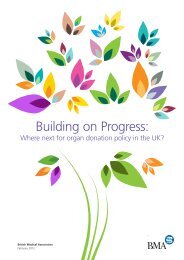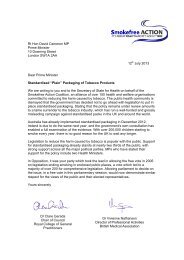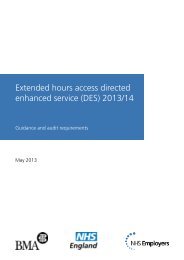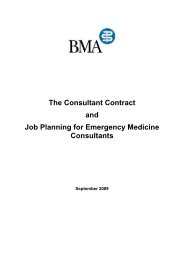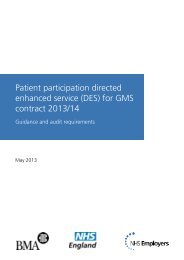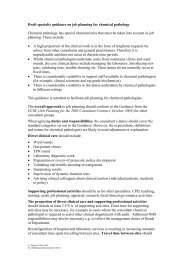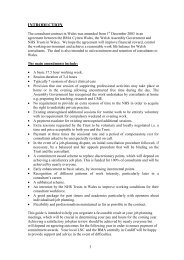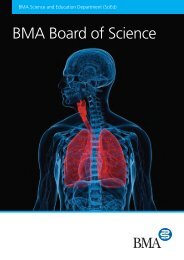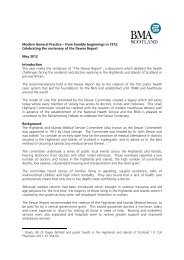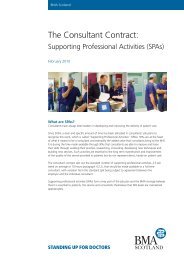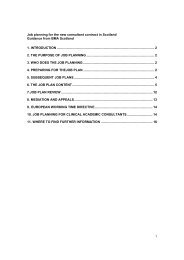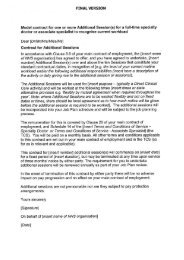Violence Report 2006 final.pdf - BMA
Violence Report 2006 final.pdf - BMA
Violence Report 2006 final.pdf - BMA
Create successful ePaper yourself
Turn your PDF publications into a flip-book with our unique Google optimized e-Paper software.
Health Policy & Economic Research Unit<br />
<strong>Violence</strong> in the workplace<br />
The experience of doctors in Northern Ireland<br />
November <strong>2006</strong><br />
improving health<br />
NORTHERN<br />
IRELAND
Health Policy & Economic Research Unit<br />
Summary<br />
Aim<br />
• The aim of the study was to explore the incidence of violence against doctors in an attempt to<br />
understand better the extent of such incidences and the impact such violence has on the lives<br />
of doctors.<br />
Method<br />
• A postal survey of 4,669 doctors in Northern Ireland was undertaken. Doctors were asked about<br />
their personal experience of workplace violence, in addition to their views and perceptions of<br />
violence in the workplace more generally.<br />
Findings<br />
• <strong>Violence</strong> is a problem in the workplace for almost half of the doctors who responded and more<br />
than a quarter were of the opinion that the level of violence had increased in their workplace over<br />
the last year.<br />
• Doctors in the SHO hospital grade were more likely to report experience of violence in the<br />
workplace, followed by GPs. Comparison with a study of workplace violence against GPs in<br />
Northern Ireland undertaken in 2003, shows that the reported incidence of workplace violence has<br />
not improved in the last 3 years.<br />
• Most respondents experienced violence from patients or from patients’ families/relatives. The<br />
incidence of verbal abuse was the most prevalent form of violence or abuse in the workplace,<br />
followed by threats and physical assaults.<br />
• More than a quarter of doctors who reported experience of workplace violence, experienced<br />
physical violence or abuse. Among those doctors, a third stated that they received minor injuries as a<br />
result of the incident and 3 per cent reported serious injuries.<br />
• The majority of violent incidents took place in the hospital ward or doctors’ office. In two-thirds of<br />
cases, respondents reported that the incident took place during working hours, whilst a fifth took<br />
place during out-of-hours.<br />
• The most frequently stated reason for a violent incident against a doctor was dissatisfaction with the<br />
service provided, followed by intoxication with alcohol/drugs, health related/personal problems or a<br />
history of violence/abuse.<br />
• In less than half of cases, some form of action was taken following the violent incident. Three<br />
quarters of the doctors reported the incident to a line manager or senior colleague and a third<br />
reported the incident to the police.<br />
<strong>Violence</strong> in the workplace – The experience of doctors in Northern Ireland 1
2<br />
Health Policy & Economic Research Unit<br />
• Following the violent incident, support was received by less than two-thirds of doctors. Around<br />
a third stated that their experience of violence had affected their work, either psychologically<br />
or physically.<br />
• The majority of respondents had not received any training on how to deal with violence from<br />
patients and training of this nature is particularly poor amongst hospital doctors.<br />
• Around half of the doctors were worried about potential violence from patients and GPs were more<br />
likely to express concern about patient violence. Two in five respondents had taken precautions<br />
against potential violence, particularly among GPs.<br />
• Less than 10 per cent of respondents reported having access to a secure facility in which to treat<br />
violent patients. The majority agreed that there should be a register of violent patients set up in each<br />
Health Board area.<br />
• More than half of the doctors reported that they had witnessed violence from patients directed at<br />
others in their workplace in the last year. <strong>Violence</strong> towards nursing staff and other doctors is more<br />
likely to occur in a hospital setting, whilst the incidence of violence against<br />
receptionists/administrators is more likely in general practice.<br />
• Only half of respondents reported the presence of a clear policy on zero tolerance to violence in<br />
their workplace. Less than half were of the opinion that, as doctors, it was possible to adopt a<br />
zero tolerance to violence.<br />
<strong>Violence</strong> in the workplace – The experience of doctors in Northern Ireland
Health Policy & Economic Research Unit<br />
Introduction<br />
The Northern Ireland Council of the <strong>BMA</strong> decided that a local campaign to highlight and tackle the<br />
issue of workplace violence against doctors was required and commissioned the <strong>BMA</strong>’s Health Policy<br />
and Economic Research Unit to undertake a study to help inform such a campaign. The aim of the<br />
study was to explore the incidence of violence against doctors in an attempt to understand better the<br />
extent of such incidences and the impact such violence has on the lives of doctors. This study is set<br />
against the background of increasing incidence of violence against the Northern Ireland healthcare<br />
workforce in recent years. This report presents the findings from a survey of doctors in Northern<br />
Ireland on the incidence and impact of violence in the workplace.<br />
<strong>Violence</strong> in the workplace – The experience of doctors in Northern Ireland 3
4<br />
Health Policy & Economic Research Unit<br />
Method<br />
A postal questionnaire was sent to a total of 4,996 doctors, representing all doctors in Northern<br />
Ireland. The questionnaire received a response from 19 per cent of the sample (969/4,996). Doctors<br />
were asked a series of questions about their personal experience of workplace violence, in addition to<br />
their views and perceptions of violence in the workplace more generally. For the purposes of this study,<br />
the definition of violence follows that used in the Government’s Zero Tolerance campaign and is<br />
defined as:<br />
‘any incident where (doctors or staff) are abused, threatened or<br />
assaulted in circumstances related to their work, involving an explicit<br />
or implicit challenge to their safety, well-being or health’.<br />
<strong>Violence</strong> in the workplace – The experience of doctors in Northern Ireland
Health Policy & Economic Research Unit<br />
Survey Results<br />
Characteristics of Respondents<br />
Table 1 shows that respondents were fairly evenly divided by gender (54% males/46% females). Whilst<br />
the majority of respondents were of white ethnic origin (95%), 4 per cent were of Asian or Black ethnic<br />
origin. The age of respondents was wide ranging from 23 years to 85 years (average age 42 years).<br />
Table 1 Ethnicity and gender of survey respondents (%)<br />
White<br />
Black<br />
Asian<br />
Other<br />
Table 2 shows that 56 per cent of respondents were hospital doctors, predominantly consultants<br />
(225/537) and 42 per cent were working in general practice, mainly as GP principals (303/407).<br />
The majority of GP respondents worked in multiple partner practices. Table 3 shows the main<br />
specialties of those respondents who reported working as hospital doctors.<br />
Table 2 Current job title of respondents (%)<br />
Male Female Total<br />
50.9<br />
0.2<br />
2.3<br />
0.6<br />
* includes principals, non-principals, locums, registrars, assistants and salaried GPs;<br />
** includes CMO, Portfolio, clinical assistant, retired, not working, CMP and medical director.<br />
<strong>Violence</strong> in the workplace – The experience of doctors in Northern Ireland 5<br />
43.8<br />
0.3<br />
1.5<br />
0.4<br />
94.8<br />
0.4<br />
3.8<br />
1.0<br />
Total 54.2 45.8 100.0<br />
Foundation year trainee<br />
Senior house officer<br />
Specialist registrar<br />
Consultant<br />
General practitioner*<br />
Staff and associate specialist<br />
Clinical Academic<br />
Other**<br />
Total<br />
No reply<br />
Frequency Per cent<br />
11<br />
109<br />
114<br />
225<br />
407<br />
68<br />
5<br />
20<br />
959<br />
10<br />
1.1<br />
11.4<br />
11.9<br />
23.5<br />
42.4<br />
7.1<br />
0.5<br />
2.1<br />
100.0
6<br />
Health Policy & Economic Research Unit<br />
Table 3 Hospital doctors by specialty<br />
General medicine (& medical oncology)<br />
Psychiatry<br />
Surgery<br />
Paediatrics<br />
Anaesthetics<br />
Radiology (& clinical oncology)<br />
A&E<br />
Obstetrics & gynaecology<br />
Pathology<br />
Geriatrics<br />
Other<br />
Total<br />
No reply<br />
Doctors’ perceptions of workplace violence<br />
Doctors were asked whether they thought there is a problem regarding the level of violence from<br />
patients in their current workplace.<br />
Almost half of respondents (43%) stated that violence is very much or somewhat of a problem in their<br />
current workplace, whilst a further 43 per cent stated that it is not really a problem and 14 per cent<br />
stated that it is not a problem at all.<br />
Table 4 shows that this perception was consistent according to type of doctor, with at least 40 per cent of<br />
both GPs and hospital doctors reporting violence to be at least somewhat of a problem in their current<br />
workplace. Nevertheless, substantial differences exist according to specialty of hospital doctors, with 57<br />
per cent of surgeons and 54 per cent of A&E doctors reporting violence as a problem in their workplace,<br />
compared with less than a third of doctors working in general medicine and pathology (Table 5)<br />
Table 4 Extent of violence as a problem in workplace by type of doctor (%)<br />
Very much a problem<br />
Somewhat of a problem<br />
Not really a problem<br />
Not a problem at all<br />
Total<br />
<strong>Violence</strong> in the workplace – The experience of doctors in Northern Ireland<br />
Frequency Per cent<br />
105<br />
50<br />
78<br />
45<br />
53<br />
28<br />
35<br />
30<br />
12<br />
18<br />
19<br />
473<br />
64<br />
22.2<br />
10.6<br />
16.5<br />
9.5<br />
11.2<br />
5.9<br />
7.4<br />
6.3<br />
2.5<br />
3.8<br />
4.0<br />
100.0<br />
General Practitioner Hospital Doctor Total<br />
7.6<br />
32.3<br />
48.5<br />
11.6<br />
100.0<br />
13.2<br />
31.2<br />
39.8<br />
15.8<br />
100.0<br />
10.8<br />
31.7<br />
43.5<br />
14.0<br />
100.0
Health Policy & Economic Research Unit<br />
Table 5 Extent of violence as a problem in workplace by hospital specialty (%)<br />
Surgery<br />
General medicine (& medical oncology)<br />
Psychiatry<br />
Obstetrics & gynaecology<br />
Paediatrics<br />
Anaesthetics<br />
Radiology (& clinical oncology)<br />
Pathology<br />
Geriatrics<br />
A&E<br />
Very much<br />
a problem<br />
Somewhat of<br />
a problem<br />
Not really<br />
a problem<br />
Doctors were also asked whether they thought that violence from patients has increased over the past<br />
year in their workplace.<br />
More than a quarter of doctors reported an increase in violence in the past year and 56% stated that<br />
it had not changed. Only two doctors (0.2%) reported a decrease.<br />
Table 6 shows that GPs were more likely to report increased violence in the workplace or indeed no<br />
change in the past year, compared with hospital doctors. Among hospital doctors, those working in<br />
A&E, anaesthetics and psychiatry specialties were more likely to report increased violence in the<br />
workplace (Table 7).<br />
Table 6 Whether violence has increased in workplace by type of doctor (%)<br />
Increased<br />
Decreased<br />
No change<br />
Not applicable<br />
Total<br />
11.5<br />
4.8<br />
34.0<br />
6.9<br />
4.5<br />
15.4<br />
7.4<br />
0.0<br />
0.0<br />
51.4<br />
46.2<br />
24.8<br />
16.0<br />
37.9<br />
38.6<br />
21.2<br />
40.7<br />
18.2<br />
55.6<br />
2.9<br />
32.1<br />
48.6<br />
48.0<br />
41.4<br />
40.9<br />
53.8<br />
29.6<br />
9.1<br />
33.3<br />
45.7<br />
Not a problem<br />
at all<br />
10.3<br />
21.9<br />
2.0<br />
13.8<br />
15.9<br />
9.6<br />
22.2<br />
72.7<br />
11.1<br />
0.0<br />
General Practitioner Hospital Doctor Total<br />
30.0<br />
0.5<br />
62.8<br />
6.7<br />
100.0<br />
27.7<br />
0.0<br />
51.2<br />
21.1<br />
100.0<br />
28.7<br />
0.2<br />
56.2<br />
14.9<br />
100.0<br />
<strong>Violence</strong> in the workplace – The experience of doctors in Northern Ireland 7
8<br />
Health Policy & Economic Research Unit<br />
Table 7 Whether violence has increased in workplace by hospital specialty (%)<br />
Surgery<br />
General medicine (& medical oncology)<br />
Psychiatry<br />
Obstetrics & gynaecology<br />
Paediatrics<br />
Anaesthetics<br />
Radiology (& clinical oncology)<br />
Pathology<br />
Geriatrics<br />
A&E<br />
Doctors’ experience of violence<br />
Whilst the survey shows that only 2 in 5 doctors (401/967) experienced violence in the past year, the<br />
majority of these doctors were verbally abused or threatened a number of times, some as many as<br />
twenty (figure 1).<br />
Figure 1 Frequency of experience by type of violence (%)<br />
100%<br />
90%<br />
80%<br />
70%<br />
60%<br />
50%<br />
40%<br />
30%<br />
20%<br />
10%<br />
0%<br />
Respondents who had experienced violence were fairly evenly divided between hospital doctors (41%)<br />
and GPs (43%). Comparison with a study of workplace violence against GPs in Northern Ireland<br />
undertaken in 2003 1<br />
, shows that the reported incidence of workplace violence has not improved in the<br />
last 3 years: 44% of GPs in 2003 compared with 43% of GPs in <strong>2006</strong>.<br />
<strong>Violence</strong> in the workplace – The experience of doctors in Northern Ireland<br />
Increased Decreased No change Not applicable<br />
23.1<br />
24.8<br />
34.7<br />
28.6<br />
31.8<br />
36.5<br />
25.9<br />
9.1<br />
11.1<br />
41.7<br />
0.0<br />
0.0<br />
0.0<br />
0.0<br />
0.0<br />
0.0<br />
0.0<br />
0.0<br />
0.0<br />
0.0<br />
57.7<br />
60.0<br />
55.1<br />
50.0<br />
52.3<br />
40.4<br />
40.7<br />
18.2<br />
61.1<br />
41.7<br />
19.2<br />
15.2<br />
10.2<br />
21.4<br />
15.9<br />
23.1<br />
33.3<br />
72.7<br />
27.8<br />
16.7<br />
Verbal abuse Threats Physical assault<br />
None Once only 2-4 times 5-6 times 7-10 times More than 10 times<br />
1 Health policy and economic research unit 2003 <strong>Violence</strong> at work: the experience of GPs in Northern Ireland. <strong>BMA</strong>: London.
Health Policy & Economic Research Unit<br />
Figure 2 shows that doctors in the SHO hospital grade (63%) were more likely to report experience of<br />
violence in the workplace, followed by GPs (43%), whilst only one in five academic doctors reported<br />
workplace violence (table 8).<br />
Four in five (79%) doctors experienced violence from patients and 52 per cent experienced violence<br />
from patients’ families/relatives. Other respondents reported experiencing violence from patients’<br />
friends or companions (14%) or from ‘others’ (3%). ‘Others’ included nurses and colleagues (Figure 3).<br />
Figure 2 <strong>Report</strong>ed experience of workplace violence according to current position (%)<br />
100%<br />
90%<br />
80%<br />
70%<br />
60%<br />
50%<br />
40%<br />
30%<br />
20%<br />
10%<br />
0%<br />
SHO GP Consultant Staff grade<br />
& Assoc<br />
Specialist<br />
Table 8 <strong>Report</strong>ed experience of workplace violence according to current position<br />
Foundation year trainee<br />
SHO<br />
Specialist registrar<br />
Staff grade and associate specialist<br />
GP (incl. principals, non-principals and locums)<br />
Consultant<br />
Clinical academic<br />
Other<br />
Foundation<br />
year trainee<br />
% reported experience<br />
of violence<br />
36.4<br />
63.0<br />
34.2<br />
36.8<br />
42.5<br />
37.1<br />
20.0<br />
30.0<br />
SpR Other Academic<br />
Total respondents (n)<br />
<strong>Violence</strong> in the workplace – The experience of doctors in Northern Ireland 9<br />
11<br />
109<br />
114<br />
68<br />
407<br />
225<br />
5<br />
20<br />
No<br />
Yes
10<br />
Health Policy & Economic Research Unit<br />
Figure 3 Perpetrators of violence against doctors (%)<br />
% of respondents<br />
90<br />
80<br />
70<br />
60<br />
50<br />
40<br />
30<br />
20<br />
10<br />
0<br />
The majority of doctors who reported experience of violence in the workplace, experienced some form<br />
of verbal abuse (96%), followed by almost half (46%) who experienced some form of threat and 10<br />
per cent who had experienced some form of physical assault.<br />
Respondents were asked about the number of times in the past year that they had experienced some<br />
form of violence or abuse. The incidence of verbal abuse was the most frequent, with 25 per cent of<br />
respondents experiencing this form of abuse more than 5 times in the last year. This was followed by<br />
threats and physical assaults. The main forms of verbal abuse reported were swearing/abusive<br />
language, shouting, verbal threats and personal intimidation (Table 9).<br />
Table 9 Forms of verbal abuse experienced by respondents<br />
Swearing/abusive language<br />
Shouting<br />
Verbal threats<br />
Personal intimidation<br />
Spitting<br />
Sectarianism<br />
Racial comments<br />
Other<br />
Patients Patients family/relatives Patients friend/companion Other<br />
More than a quarter (27%-108/401) of doctors who reported experience of workplace violence,<br />
experienced physical violence or abuse. These incidents ranged from being kicked, scratched, shoved,<br />
urinated upon, hit and punched, to knife assaults and being threatened with a chair, a drip stand and<br />
hot soup. Among those doctors who had experienced physical violence or abuse, a third (35%) stated<br />
that they received minor injuries as a result of the incident and 3 per cent reported serious injuries.<br />
<strong>Violence</strong> in the workplace – The experience of doctors in Northern Ireland<br />
% reported experience Total respondents<br />
89.5<br />
73.1<br />
48.4<br />
34.2<br />
9.5<br />
9.0<br />
3.5<br />
3.5<br />
359<br />
293<br />
194<br />
137<br />
38<br />
36<br />
14<br />
14
Health Policy & Economic Research Unit<br />
Table 10 shows that for the majority of respondents, the violent incident took place in the hospital<br />
ward (27%) or doctor’s office (23%). Among GPs, the majority of incidents took place either in their<br />
office or waiting room, whilst for hospital doctors, the most frequently cited location was the hospital<br />
ward or A&E. Other reported locations included out-of-hours clinics, community health centres or<br />
outpatient clinics. Several respondents also reported verbal abuse over the telephone. In two-thirds of<br />
cases (68%), respondents reported the incident taking place during working hours. However, a fifth<br />
(21%) of doctors reported the violent incident taking place during out-of-hours (table 11).<br />
Table 10 Location where violent incident took place by type of doctor (%)<br />
Hospital-A&E<br />
Hospital-ward<br />
Hospital-public area<br />
Your office<br />
GP waiting room<br />
Patient’s home<br />
Other<br />
Total<br />
Table 11 Timing of violent incident by type of doctor (%)<br />
During working hours<br />
Out-of-hours<br />
Both<br />
Total<br />
General Practitioner Hospital doctor Total respondents<br />
3.7<br />
2.3<br />
0.0<br />
41.6<br />
26.0<br />
12.3<br />
14.2<br />
100.0<br />
28.0<br />
45.5<br />
6.1<br />
7.9<br />
0.7<br />
0.4<br />
11.5<br />
100.0<br />
17.3<br />
26.5<br />
3.4<br />
22.7<br />
11.8<br />
5.6<br />
12.7<br />
100.0<br />
General Practitioner Hospital doctor Total respondents<br />
76.8<br />
11.6<br />
11.6<br />
100.0<br />
60.2<br />
28.9<br />
10.9<br />
100.0<br />
67.5<br />
21.3<br />
11.2<br />
100.0<br />
It is often suggested that racial or political motivations lie behind violent incidents. However, only 1<br />
respondent stated that the incident of violence against them was politically motivated. Instead key<br />
motivations included drugs, alcohol, mental illness and confusion. Respondents were asked why they<br />
thought the violent incident against them had occurred. Table 12 shows that the most frequently<br />
stated reason is that the perpetrator was dissatisfied with the service provided, followed by intoxication<br />
with alcohol/drugs, health related/personal problems or a history of violence/abuse. Dissatisfaction with<br />
the service provided includes patients’ high expectations of the NHS and frustration with long waiting<br />
times, refusal to prescribe or admit for treatment and dissatisfaction with diagnosis received.<br />
<strong>Violence</strong> in the workplace – The experience of doctors in Northern Ireland 11
12<br />
Health Policy & Economic Research Unit<br />
Table 12 Perceived reasons for violent incident<br />
Perpetrator was dissatisfied with service provided<br />
Perpetrator was intoxicated with alcohol/drugs<br />
Perpetrator has health related/personal problems<br />
Perpetrator has a history of violence/abuse<br />
Perpetrator received bad news<br />
Perpetrator was provoked<br />
Don’t Know<br />
Other<br />
Note: more than one response may apply<br />
Two in five doctors (41%) reported knowing the perpetrator or the perpetrator’s family before the<br />
violent incident took place, whilst 59 per cent stated that they did not know the perpetrator. This<br />
differs somewhat by type of doctor, with two-thirds (66%) of GPs reporting that they knew either the<br />
perpetrator or the perpetrator’s family prior to the incident, compared with less than a quarter (23%)<br />
of hospital doctors.<br />
In less than half of cases (45%), some form of action was taken following the incident. Where action<br />
did follow a violent incident, three quarters of respondents reported the incident (124/166). This was<br />
often to a line manager, senior consultant, medical director, practice manager or other senior staff<br />
member in the workplace. In a third of cases (63/166), the incident was reported to the police and in<br />
the majority of these cases (69%), some action was taken by the police. Following the violent incident,<br />
support was received by less than two-thirds of respondents (58%). This was largely in the form of<br />
peer support (36%). Managerial support (8%), debriefing (4%) and counselling service (1%) were<br />
received by few respondents.<br />
Doctors were asked whether the violent incident had affected their work. Around a third (31%) said<br />
that their experience of violence had affected their work and in many cases the reported impact was<br />
both psychological and physical. Impacts include greater awareness of personal safety, ensuring a<br />
secure environment, increased anxiety and stress, loss of confidence and professional disillusionment.<br />
All respondents, regardless of whether they themselves had directly experienced violence, were asked<br />
whether they had ever considered withholding treatment from a patient due to the threat of abuse or<br />
violence. More than a third (38%) of doctors had considered withholding treatment. Almost half of<br />
GPs (45%) had considered withholding treatment due to the threat of patient violence, compared<br />
with a third of hospital doctors (33%).<br />
<strong>Violence</strong> in the workplace – The experience of doctors in Northern Ireland<br />
Frequency % of total respondents<br />
210<br />
167<br />
137<br />
133<br />
42<br />
1<br />
14<br />
41<br />
52.4<br />
41.6<br />
34.2<br />
33.2<br />
10.5<br />
0.2<br />
3.5<br />
10.2
Health Policy & Economic Research Unit<br />
The government has called for training of NHS staff to deal with violence from patients, however the<br />
majority of doctors (64%) had not received any such training. This does vary somewhat according to<br />
type of doctor, with more than half of GPs (53%) reporting receiving some form of training on how to<br />
deal with violence from patients, compared with less than a quarter (23%) of hospital doctors.<br />
Figure 4 shows that more than half of respondents (57%) were very or fairly worried about potential<br />
violence from patients, whilst a quarter (25%) were not worried at all. Doctors working in general<br />
practice were more likely to be worried about patient violence (67%), compared with doctors working<br />
in hospitals (49%). Two in five respondents (41%) had taken precautions against potential violence.<br />
Again, this was more likely to be the case among GPs (62%), compared with hospital doctors (25%).<br />
Panic alarms/buttons were the most widely adopted precaution, but others included room layout,<br />
chaperoning and CCTV.<br />
Less than 10% of doctors reported having access to a secure facility in which to treat violent patients.<br />
Hospital doctors (11%) were more likely to have access to such a facility, compared with GPs (4%).<br />
The vast majority of doctors (90%) agreed that there should be a register of violent patients set up in<br />
each Health Board area.<br />
Figure 4 Concern about potential violence from patients by type of doctor (%)<br />
100%<br />
90%<br />
80%<br />
70%<br />
60%<br />
50%<br />
40%<br />
30%<br />
20%<br />
10%<br />
0%<br />
GP Hospital Total respondents<br />
Very worried A little worried Moderately worried Not at all worried<br />
<strong>Violence</strong> in the workplace – The experience of doctors in Northern Ireland 13
14<br />
Health Policy & Economic Research Unit<br />
<strong>Violence</strong> in the workplace<br />
More than half (57%) of respondents reported that they had witnessed violence from patients directed<br />
at others in their workplace in the last year. This was largely directed at nursing staff (31%) and<br />
receptionist/administrators (32%) and was in the form of verbal abuse (54%), threats (19%) or assault<br />
(10%). According to table 13, violence towards nursing staff and other doctors was more likely to<br />
occur in a hospital setting, whilst the incidence of violence against receptionists/administrators was<br />
more likely in general practice.<br />
Table 13 Work colleagues at which abuse is directed by type of doctor (%)<br />
Nursing staff<br />
Receptionist/administrator<br />
Other doctors<br />
Porter/cleaner<br />
Other<br />
Total<br />
Note: more than one response may apply<br />
The government has launched a Zero Tolerance campaign to reinforce the message that violence against<br />
health service staff will not be tolerated. Doctors were asked whether there was a clear policy on zero<br />
tolerance to violence in their workplace. Only half of respondents (52%) reported the presence of such a<br />
policy. GPs (70%) were more likely to have such a clear policy in their workplace, compared with hospital<br />
doctors (36%). Respondents were also asked whether as doctors, they thought that it was possible to<br />
adopt a zero tolerance to violence. Less than half of respondents (48%) stated that it is possible, and a<br />
further third (33%) did not think that it is possible to adopt a zero tolerance to violence. GPs (61%) were<br />
more likely to be positive about adopting a policy of zero tolerance to violence compared with hospital<br />
doctors (38%). Respondents who agreed that it is possible to adopt a zero tolerance to violence were<br />
generally of the opinion that any form of abuse or violence is not acceptable and rules should be put in<br />
place to enforce this. Many also stressed that the zero tolerance policy must be made clear to all patients<br />
and members of the public if it is to be effective.<br />
<strong>Violence</strong> in the workplace – The experience of doctors in Northern Ireland<br />
General Practitioner Hospital doctor Total respondents<br />
13.6<br />
65.0<br />
19.4<br />
0.9<br />
1.2<br />
100.0<br />
46.2<br />
15.3<br />
30.1<br />
2.7<br />
5.6<br />
100.0<br />
33.7<br />
34.4<br />
26.0<br />
2.0<br />
3.9<br />
100.0
Health Policy & Economic Research Unit<br />
<strong>Violence</strong> in the workplace – The experience of doctors in Northern Ireland 15
16<br />
Health Policy & Economic Research Unit<br />
<strong>Violence</strong> in the workplace – The experience of doctors in Northern Ireland
Health Policy & Economic Research Unit<br />
British Medical Association, <strong>BMA</strong> House, Tavistock Square, London, WC1H 9JP<br />
www.bma.org.uk<br />
© British Medical Association, <strong>2006</strong> CODE:<br />
<strong>BMA</strong> 47050 / AG / HP&ERU / 15.08



